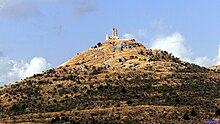Jurisdicción de Lara
| Municipality of Jurisdicción de Lara | ||
|---|---|---|
 Lara de los Infantes - town view
|
||
| coat of arms | Map of Spain | |

|
|
|
| Basic data | ||
| Autonomous Community : |
|
|
| Province : | Burgos | |
| Comarca : | Sierra de la Demanda (Comarca) | |
| Coordinates | 42 ° 8 ′ N , 3 ° 27 ′ W | |
| Height : | 1000 msnm | |
| Area : | 25.04 km² | |
| Residents : | 33 (Jan. 1, 2019) | |
| Population density : | 1.32 inhabitants / km² | |
| Postal code : | 09600 | |
| Municipality number ( INE ): | 09191 | |
| administration | ||
| Website : | Jurisdicción de Lara | |
Jurisdicción de Lara is a municipality ( municipio ) belonging to the poorly populated region of the Serranía Celtibérica with a total of only 33 inhabitants (as of January 1, 2019) in the northern Spanish province of Burgos in the autonomous community of Castile-León . The main town of the municipality, which is historically important for the history of Castile and thus ultimately for the whole of Spain, is Lara de los Infantes ; the hamlets (pedanías) La Aceña , Paúles and Vega de Lara also belong to it. The main town is on the Camino del Cid .
Location and climate
The municipality Jurisdicción de Lara is located in the headwaters of several brooks (arroyos) on the western edge of the Sierra de la Demanda at an altitude of around 1000 m . The provincial capital, Burgos, is about 40 km to the northwest. The climate is temperate to warm; Rain (approx. 565 mm / year) falls mainly in the winter half-year.
Population development
| year | 1857 | 1900 | 1950 | 2000 | 2018 |
| Residents | 564 | 530 | 396 | 66 | 33 |
The significant population decline since the beginning of the 20th century is mainly due to the mechanization of agriculture , the abandonment of small farms and the resulting lack of jobs in the countryside and especially in the mountain regions.
economy
The basis of the self-sufficiency economy has always been cattle breeding ( sheep and goats ); agriculture ( barley and wheat ) only played a subordinate role. A long-life cheese was made from the milk of the animals, which could sometimes be sold in the markets of distant cities. The same applies to sheep's wool , which, however, was also required for the manufacture of one's own clothing; ropes, etc. were woven from the goat hair. In the meantime, day and weekend tourism and the rental of holiday homes (casas rurales) play an important role in the economic life of the municipality.
history
Small finds from the Celtic and Roman times were made in the municipality; The church of Santa María de Quintanilla de las Viñas , located just 4 km to the west, dates from the Visigothic period . There is no archaeological evidence of the presence of the Moors . The area was probably recaptured ( reconquista ) by Count Diego Rodríguez Porcelos at the end of the 9th century . The founding of Lara, probably as part of the repopulation ( repoblación ) , was probably made at the beginning of the 10th century by his later successor Fernán González . In the 12th century, Lara received her own legal letter ( fuero ) from Alfonso VII - a clear indication of the importance of the place at that time. The place received the addition de los Infantes only in the late Middle Ages in memory of the sometimes legendary stories of the "Seven Infantes of Lara", who are said to have been beheaded by Almansor , the leader of the Moors around the year 1000; their seven heads were reportedly discovered in 1579 in the church of Santa María in Salas de los Infantes .
Attractions
- The Iglesia de Nuestra Señora de la Natividad , which was largely rebuilt in the 16th century, is dedicated to the birth of Mary and still contains some architectural elements from earlier times. The apse is clearly Romanesque , while the portal is built in Gothic styles . The mighty but unadorned bell tower (campanario) even refers to a construction period in the 17th or 18th century.
- A spring (fuente romana) that is said to have been used in Roman times is only about 200 m outside the village.
- Surroundings
- Fernán González, the actual founder of Castile, is said to have been born around the year 910 in the castle (Castillo de Lara de los Infantes) located on a hilltop about 2 km west of the village ; the precisely hewn stones of the outer walls, however, indicate restorations in later times. Today there are only a few remains of the wall.
Web links
- Lara de los Infantes - photos + information (wikiburgos, spanish)
- Lara de los Infantes - photo + short information (Spanish)
Individual evidence
- ↑ Cifras oficiales de población resultantes de la revisión del Padrón municipal a 1 de enero . Population statistics from the Instituto Nacional de Estadística (population update).
- ↑ Lara de los Infantes - Camino del Cid
- ↑ Jurisdicción de Lara - Climate tables
- ↑ Jurisdicción de Lara - Population Development
- ↑ Lara - Fuero
- ↑ Lara de los Infantes - Church
- ↑ Lara de los Infantes - Church
- ↑ Lara de los Infantes - source
- ↑ Lara de los Infantes - Castle


